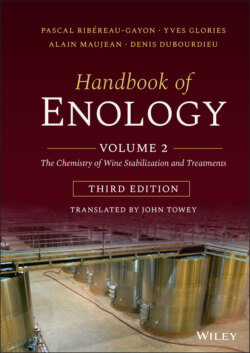Читать книгу Handbook of Enology, Volume 2 - Pascal Ribéreau-Gayon - Страница 57
2.3.4 C6 Polyols: Mannitol, Sorbitol, and meso‐Inositol
ОглавлениеThese three compounds (Table 2.3) have six alcohol functions. The first two are linear, while the third is cyclic.
Mannitol is derived from the reduction of the aldehyde group on mannose. In wine, it is produced by the reduction of the ketone group on fructose by lactic acid bacteria. Mannitol is usually present in very small quantities. Higher concentrations are due to lactic acid bacteria or possibly B. cinerea. Abnormally high concentrations indicate severe lactic spoilage.
Sorbitol results from the reduction of the aldehyde group on glucose. This diastereoisomer of mannitol is totally absent from healthy grapes. Varying quantities are formed when B. cinerea develops. Alcoholic fermentation produces approximately 30 mg/l. Lactic acid bacteria do not form this compound. Large quantities of sorbitol indicate that wine has been mixed with fruit wines. Besides rowan berries (Sorbus aucuparia, hence its name), apples, pears, and cherries also have a high sorbitol content.
meso‐Inositol is a normal component of grapes and wine. It is a cyclic polyol with six carbon atoms, each carrying a hydroxyl radical. Among the nine inositol stereoisomers, which are all diastereoisomers of each other, meso‐inositol has a plane of symmetry passing through C1 and C4. This polyol is widespread in the animal and plant kingdoms. It is a vital growth factor for many microorganisms, especially certain yeasts.
TABLE 2.4 Aliphatic Fatty Acids Among the Volatile Components in Wine(Ribéreau‐Gayon et al., 1982)
| Formula | Name | Boiling point (°C) | Concentration (g/l) | Comments |
|---|---|---|---|---|
| H−COOH | Formic | 101 | 0.05 | |
| CH 3 −COOH | Acetic | 118 | 0.5 | |
| CH3−CH2−COOH | Propionic | 141 | Traces | |
| CH3−CH2−CH2−COOH | Butyric | 163 | Traces | |
| Isobutyric | 154 | Traces | 2‐Methyl‐propionic acid | |
| CH3−CH2−CH2−CH2−COOH | Valerianic | 186 | Traces | |
| Isovalerianic | 177 | ? | 3‐Methyl‐butyric acid | |
| 2‐Methyl‐butyric | ? | |||
| CH3−(CH2)4−COOH | Caproic | 205 | Traces | Hexanoic acid |
| CH3−(CH2)5−COOH | Enanthic | 223 | Traces | Heptanoic acid |
| CH3−(CH2)6−COOH | Caprylic | Traces | Octanoic acid | |
| CH3−(CH2)7−COOH | Pelargonic | 253 | ? | Nonanoic acid |
| CH3−(CH2)8−COOH | Capric | 270 | Traces | Decanoic acid |
It is difficult to attribute any organoleptic role to C6 polyols.
